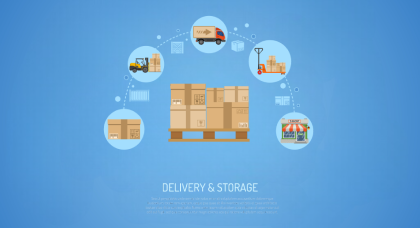Comprehensive Overview of Real-Time Visibility in Last-Mile Transportation Management Systems (TMS)

In the dynamic landscape of logistics and supply chain management, real-time visibility in Last-Mile Transportation Management Systems (TMS) has emerged as a pivotal component for enhancing operational efficiency and customer satisfaction. A true network-based platform is essential for providing all stakeholders with a unified and consistent view of the entire delivery process, enriched with context-sensitive visibility. This approach not only fosters transparency but also drives significant improvements across various aspects of Last-Mile delivery.
Key Benefits of Real-Time Visibility in Last-Mile TMS:

Enhanced Customer Satisfaction:
Real-time visibility allows customers to receive up-to-the-minute updates on their shipment status, delivery times, and location. This transparency builds trust and confidence, ensuring that customers are always informed and can plan accordingly. By providing accurate and timely information, businesses can significantly improve the overall customer experience, leading to higher satisfaction rates and increased loyalty.

Operational Efficiency
A network-based TMS enables seamless communication and coordination among all stakeholders, including shippers, carriers, and customers. This streamlined interaction helps to identify and address potential issues proactively, minimizing delays and disruptions. By optimizing delivery routes and schedules, businesses can achieve higher levels of efficiency, reduce operational costs, and ensure timely deliveries.

Proactive Problem-Solving
Context-sensitive visibility provides a comprehensive understanding of the entire delivery process, allowing for immediate identification and resolution of potential problems. This proactive approach helps to prevent minor issues from escalating into major disruptions, ensuring a smooth and reliable delivery experience. By anticipating and addressing challenges before they impact the customer, businesses can maintain high standards of service and reliability.

Real-Time ETA Updates
One of the critical features of a modern Last-Mile TMS is the ability to provide real-time Estimated Time of Arrival (ETA) updates. These updates help manage customer expectations by providing accurate delivery windows, which allows customers to plan their schedules better. For businesses, real-time ETA updates enhance route management by enabling dynamic adjustments to delivery routes based on current conditions, ensuring timely deliveries and optimal resource utilization.

Better Exception Management
Real-time visibility also significantly improves exception management by providing immediate access to proof of delivery and other critical data. When deviations from the planned delivery process occur, such as delays or damaged goods, real-time information allows for swift identification and resolution of issues. This capability ensures that any problems are promptly addressed, reducing the impact on customers and maintaining high service levels.

Better Communication
Effective communication is crucial for successful Last-Mile delivery operations. Real time visibility facilitates seamless information exchange between all parties involved, ensuring that everyone is on the same page. This enhanced communication capability helps to coordinate efforts, resolve issues quickly, and maintain a high level of service quality throughout the delivery process.

Cost Reduction
By optimizing delivery routes, schedules, and resource allocation, real-time visibility in TMS helps to minimize fuel consumption, labor costs, and other operational expenses. This cost-effective approach enables businesses to deliver high-quality services at competitive prices, improving their bottom line and overall profitability.

Data-Driven Decisions
Access to real-time data and analytics empowers businesses to make informed decisions based on accurate and up-to-date information. This data-driven approach helps to identify trends, optimize operations, and implement best practices for continuous improvement. By leveraging real-time insights, businesses can enhance their strategic planning and operational performance.

Compliance and Safety
Ensuring compliance with regulatory requirements and maintaining high safety standards are critical aspects of Last-Mile delivery. Real-time visibility provides detailed information on delivery operations, enabling businesses to monitor and enforce compliance with industry regulations. Additionally, it helps to identify and mitigate potential safety risks, ensuring the well-being of both delivery personnel and customers.

Competitive Advantage
In a highly competitive market, real-time visibility offers a significant edge by enhancing the efficiency, reliability, and transparency of delivery operations. Businesses that leverage real-time TMS can provide superior services, differentiate themselves from competitors, and attract more customers. By continuously improving their delivery processes, they can maintain a competitive advantage and drive long-term success.
In conclusion, incorporating real-time visibility into Last-Mile TMS is no longer an option but a necessity for businesses aiming to thrive in today’s fast-paced and customer-centric environment. By adopting a network-based platform with context- sensitive visibility, companies can ensure that all stakeholders have access to the same accurate and up-to-date information, fostering trust and collaboration. This approach leads to enhanced customer satisfaction, improved operational efficiency, and a proactive problem-solving culture, ultimately driving business growth and success.
By optimizing delivery routes, reducing costs, and enabling data-driven decisions, real-time visibility in Last-Mile TMS provides a comprehensive solution for modern logistics challenges. Embracing this technology not only ensures compliance and safety but also delivers a significant competitive advantage, positioning businesses for sustained success in the ever-evolving logistics landscape.
News

Amazon deploying AI tech in delivery vans
Vision-Assisted Package Retrieval aims to help drivers quickly...

Forward Air names new chief...
Forward Air announced a new chief commercial officer Wednesday after...
Newsletter

E-commerce Boom: How Last-Mile Innovations are...
The global e-commerce sector has experienced unprecedented growth...
Gartner

Market Guide for Last-Mile Delivery...
Demand for Last-Mile delivery applications continues to grow, gathering interest...